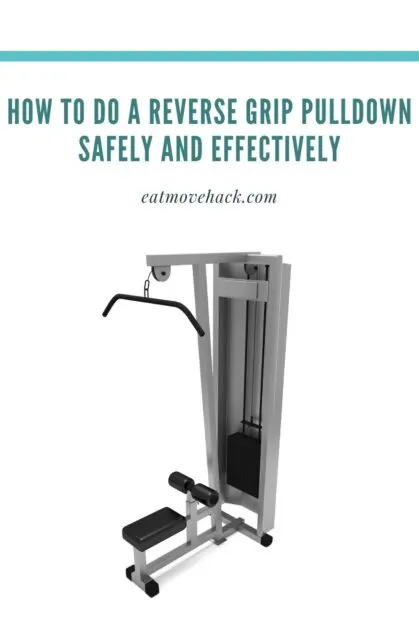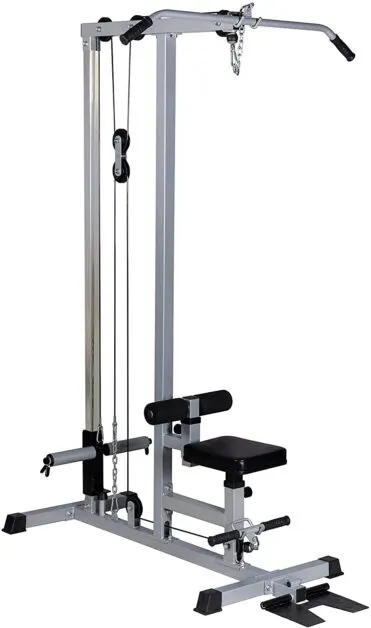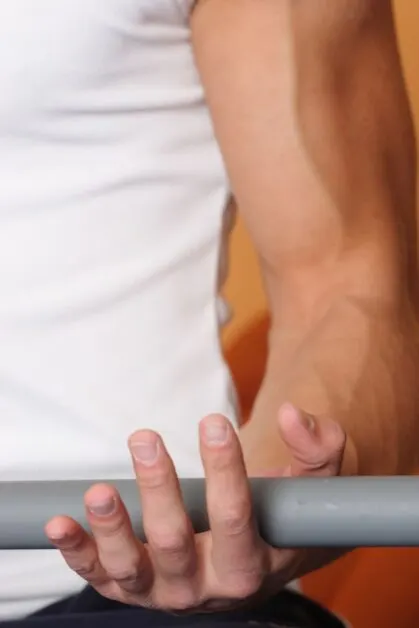Some of the links in this post are affiliate links. This means if you click on the link and purchase the item, we will receive an affiliate commission from the vendor at no extra cost to you. These business relationships allow us to keep bringing you great EatMoveHack content. All opinions remain our own.
At a Glance Info:
Targets: Lats (latissimus dorsi), Rhomboids, upper back
Equipment Needed: Adjustable cable machine with straight bar
Level: Beginner to Expert
Pulldown exercises are perfect for increasing muscle mass in the upper back and shoulders when building upper body strength. Variations of the classic pulldown can target and tone areas more acutely than regular pulldowns can. For example, reverse grip pulldowns can more efficiently target the lower lat muscles than an overhand pulldown.
For those wanting to strengthen their lower back for better posture, reduction of lower back pain, or as part of a comprehensive bodybuilding program, reverse grip pulldowns are an effective exercise. They make a great alternative to pull-ups for those building their strength or seeking more variety in their upper body workout.

What is a Reverse Grip Pulldown and What Are the Benefits?
The Reverse Grip Pulldown
A reverse grip pulldown is a strength training exercise that targets the lower region of the latissimus dorsi, known commonly as lats. It requires access to a cable machine with a straight bar from a seated position while facing towards the weight stack. This is a simple exercise that can be done by almost anyone.
Dorian Yates, a world-famous bodybuilder from England, suggests using reverse grip pulldowns to develop better lower lat strength and width.
Benefits of Reverse Grip Pulldown
A reverse grip pulldown targets the lats, which are the largest muscle of the upper body. They are found in the mid-to-lower region of the back. Lat muscles are instrumental for developing good posture, supporting a healthy spine and our core region. Reverse grip pulldowns help to keep lats strong and in good working condition.
Other benefits of a reverse grip pulldown include:
- Improves lower back stability
- Targets biceps and triceps in addition to the lower back.
- Suitable for all fitness levels
- Strengthens core (suggest linking to bicycle crunches blog)
- Works upper chest and upper arms
- Thickens waist
How to do a Reverse Grip Pulldown
You can do reverse grip pulldowns using either a V-bar or a wide straight bar. You could try using both bars to vary your workouts to maximize your results. This tutorial will explain the best way to execute a reverse grip pulldown using a straight bar.
When starting a new exercise routine, always check with your healthcare professional to ensure the program is right for you. Start slow and use lighter weights until you can maintain the correct form from the beginning of the exercise until the end.
Equipment
For this exercise, you will need the following:
- Cable machine
- Straight bar attachment
- Water
- Comfortable athletic clothing
- Small towel
Step One: Prepare the Machine
Follow the machine’s directions to select and secure your desired weight. Adjust the height of the bench so that when you sit, your feet are flat and your knees are comfortable and at a 90-degree angle. If you’re using equipment at a public training facility, be sure to wipe down the equipment before use.

How to Select the Correct Weight
When you are first starting out, it is crucial to select a comfortable weight. You should be able to complete the desired number of repetitions with good form. As you get stronger, you can gradually increase the weight.
How to Adjust the Seat
The seat on the pulldown machine should be adjusted so that your legs can bend at a comfortable angle. This is usually between 90 and 135 degrees to the floor. In addition, you should adjust your foot position so that you feel stable and secure.
Step Two: Prepare to Exercise
Stand in front of the machine with the bench between your legs. With palms facing towards you, reach up and grab the straight bar. Keep your hands close together, about shoulder-width apart. Curl your fingers around the bar to secure a firm grip.
While hands are holding the bar, sit down. Keep your arms relaxed and almost fully extended overhead, and allow the bar to pull down with you. Never overextend your arms. Elbows should be kept slightly bent throughout all steps of the exercise.
Step Three: Check Your Form
Before starting the pulldown exercise, make sure your body’s form is correct. Your back should be straight and your core engaged. To engage your core, bring your navel towards your spine and extend your neck until you find a position that’s comfortable and stable.
Avoid angling your head forward or backward; always keep your neck in a neutral position.
Step Four: Do a Reverse Grip Pull Down

Pull Down the Bar
With palms facing you, lean back slightly and bring the bar down to meet and pull your elbows to your waist. Your back and shoulder blade muscles should be engaged. Do not pull the bar lower than your chest. If this happens, move closer to the weights a couple of inches or adjust the height of your seat.
Raise the Bar
Slowly return the bar to its starting position. Keep your back muscles tight and shoulder blades pinched together as you do this. Return to the top of the movement until elbows are almost at full extension. Always maintain tension in your arms and back during the duration of the exercise.
Step Five: Repeat
Repeat steps one through four until you’ve completed your desired number of reps.
Common Mistakes to Avoid With Reverse Grip PullDowns
If done improperly, any strengthening exercise can result in injury. To prevent injuries, always maintain good form in every weight-bearing activity.
Reverse grip pulldowns strengthen and support the lower back, shoulder, and even several muscles in your arms. Mistakes done during this exercise can lead to ineffective results or even muscle strain. A poorly executed reverse grip pulldown can lead to a painful pulled muscle in severe instances.
To maximize your exercise efforts and prevent injury during a reverse grip pulldown, avoid the following common mistakes:
1.Use of a Too Heavy Weight
Many muscle injuries occur when the weight being used is too heavy. Remember, your body is constantly undergoing changes, and the amount of weight you can lift will vary. If you cannot maintain good form for the exercise duration, it’s best to lower your weight.
2.Improper Neck Position
Keeping your neck in a neutral position is paramount to avoid neck strain. In reverse grip pulldowns, it’s easy to unwittingly throw the head backwards while pulling the bar down or push your head forward when raising your arms back up. Pay attention to your head’s position.
A tip to keep your neck neutral is to focus your eyes on a single spot in the distance. This can help your head stay fixed in a relaxed, neutral position.
3.Hands Wider than Shoulder Grip
Hands should not be further than shoulder-width apart. Keeping them at this distance focuses the muscles in your lower back and inner shoulder blades on doing the work. If hands are wider apart, different muscles will do the job.
4.Engaging Your Forearms
Your forearms should not do the work of pulling the bar down. The muscles in your back should be activated. To avoid having your wrists and forearms do most of the work, imagine you are pulling down from your armpits. This will help to ensure your upper lats are activated.
Variations of a Reverse Grip Pulldown
While a reverse grip pulldown is a variation of the traditional pulldown, this exercise offers plenty of variety in and of itself. Some variations to try include:
Cable Machine Free Variation
Don’t let not having access to a cable weight machine stop you from earning the benefits of a reverse pulldown exercise. All you have to do is simply adjust your strategy and equipment. If you have resistance bands, try the following:
- Take a resistance band loop it over a secure door frame or hook.
- Tie the ends of the band in a knot to create a loop.
- Kneel down and grab the resistance band with palms facing towards you, hands shoulder-width apart.
- Lean back slightly and pull through the full range of motion as you would with a cable pulley.

